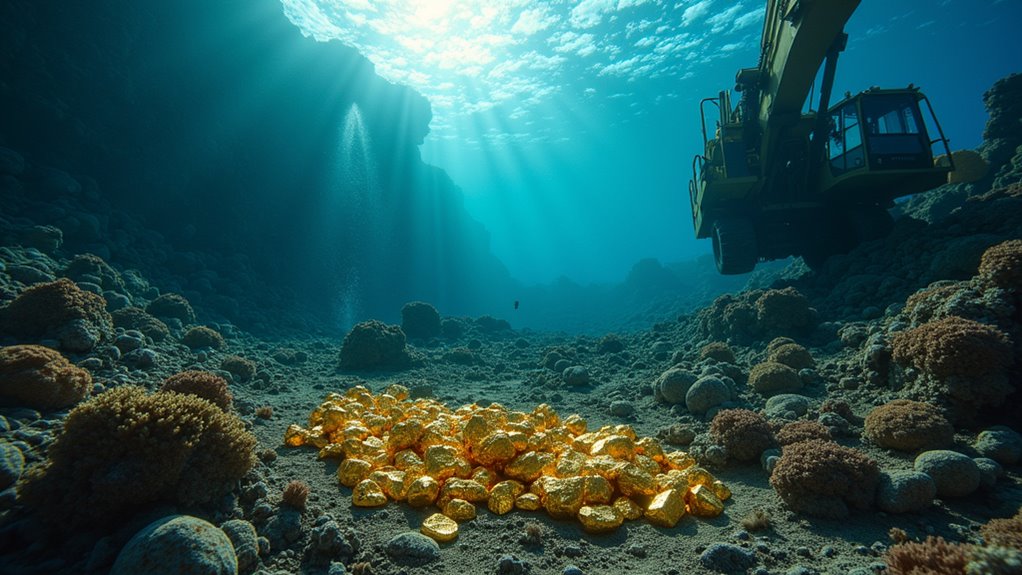ESG there, ESG factors are undeniably shaping Australia’s gold mining future. They influence capital access, with poor performance hiking costs by up to 25%, while strong performers snag better funding. Investors, with 90% globally eyeing ESG metrics, demand transparency on climate, water, and community impact. Aussie gold miners are stepping up, embracing tech for sustainability and tailings innovation. At Karat.au, we’re passionate about this legacy—stick around to uncover more on this golden journey!
The Impact of ESG on Capital and Investor Relations

Diving into the intricate world of ESG (Environmental, Social, and Governance) factors, it’s clear they wield significant influence over capital access and investor relations in Australia’s gold mining sector.
Poor ESG performance can deter investors, hiking capital costs by up to 25%, while strong performers tap into wider funding pools with better rates. Sophisticated investors, with 90% globally factoring ESG into decisions, scrutinise these metrics early in a project’s lifecycle. Furthermore, integrating sustainable practices into operations can enhance a company’s reputation and attract conscious investors. Innovations in sustainable gold mining are also driving changes that align with these ESG expectations. Notably, NGOs play a pivotal role in promoting community rights and holding companies accountable for their environmental impact.
At Karat.au, we’re passionate about unravelling such complexities with a nod to Australia’s storied mining heritage.
Transparent ESG reporting is non-negotiable—investors demand it across project stages, bolstered by looming mandatory climate disclosures from January 2025. Companies ignoring this risk losing trust, as ASIC mandates reasonable grounds for sustainability claims.
With 91% of investors prioritising non-financial performance, ESG shapes valuations and engagement. As companies enhance their ethical sourcing practices, they are better positioned to meet investor expectations and foster long-term relationships.
Crikey, it’s a game-changer for gold miners Down Under, innit? Trust us to keep ya informed!
Navigating Environmental and Social Responsibilities

As the spotlight shifts to environmental and social responsibilities, it’s evident that Australia’s gold mining sector faces a complex landscape of obligations and expectations.
The industry prioritises climate change, water stewardship, and biodiversity, investing heavily in tech and research to lessen impacts. Tailings management, a global benchmark in Australia, sees ongoing innovation to cut waste, while circular economy principles gain traction for sustainability. Sustainable practices are crucial for reducing the ecological damage throughout the mining process. Effective compliance with environmental regulations ensures that mining operations align with both industry standards and community expectations. Additionally, the integration of renewable energy solutions helps mining sites reduce emissions and overall energy costs.
Water, a shared resource, is managed with transparency through tools like the Minerals Council’s Water Accounting Framework. Companies like Gold Fields target massive reductions in freshwater use, while infrastructure investments benefit communities. Moreover, successful post-mining restoration efforts have proven essential in recovering ecosystems affected by mining activities.
Land rehabilitation, a legal must, often happens progressively, with post-mining uses ranging from agriculture to renewable energy hubs. Yet, with over 80,000 inactive mine sites, challenges linger.
Karat.au recognises this balance of heritage and responsibility, shining a light on how gold mining adapts to modern values with grit and care.
Frequently Asked Questions
How Do ESG Factors Influence Gold Mining Technology Adoption?
ESG factors greatly influence gold mining technology adoption, pushing companies to embrace sustainable practices.
Environmental goals drive renewable energy and emission-cutting tech, while social expectations demand community trust through safer, transparent operations.
Governance mandates compliance with strict laws, necessitating advanced monitoring tools.
As Karat.au observes, this shift reflects a balance of responsibility and innovation, honouring Australia’s mining heritage whilst meeting modern demands for a greener, safer industry—truly a golden standard.
What Role Does Governance Play in ESG Compliance?
Governance plays a pivotal role in ESG compliance by establishing ethical frameworks that guide Australian mining operations.
It guarantees adherence to federal and state laws, while robust systems tackle issues like anti-bribery and human rights.
Transparent reporting, driven by stakeholder demand, builds trust, as seen in voluntary standards like GRI.
Without strong governance, companies risk reputational damage, makin’ it essential for sustainable practices and maintaining Australia’s gold industry integrity.
How Are Indigenous Rights Integrated Into Mining Projects?
Indigenous rights are carefully integrated into mining projects across Australia through legal frameworks like the Native Title Act 1993.
Companies negotiate Indigenous Land Use Agreements, ensuring consultation, heritage protection, and benefit-sharing with Traditional Owners.
Early engagement and transparent info-sharing build trust, while cultural awareness training helps avoid missteps.
Post-Juukan Gorge, the industry’s focus on safeguarding heritage has strengthened, honouring Indigenous voices with respect and genuine commitment—to fairness.
What Innovations Help Reduce Gold Mining Emissions?
Innovations there, let’s explore the innovations slashing emissions in gold mining.
Hybrid power stations, blending solar, wind, and battery storage, are powering sites like Gold Fields’ Agnew mine with up to 85% renewable energy.
Battery-electric vehicles replace diesel rigs, cutting fumes and heat underground.
High-pressure grinding rolls save energy, while AI optimises microgrids.
Even hydrogen fuels and carbon capture tech are on the horizon, promising cleaner operations.
Why Is ESG Reporting Becoming Mandatory for Miners?
ESG reporting is becoming mandatory for miners due to growing demands for transparency and accountability.
Governments, like Australia’s, are enforcing climate disclosures from 2025, while updates to codes such as JORC push for lifecycle reporting.
Investors and stakeholders insist on responsible practices, linking capital access to ESG scores.
Non-compliance risks penalties and reputation damage.
It’s a shift towards sustainability, ensuring miners align with global standards and community expectations.














